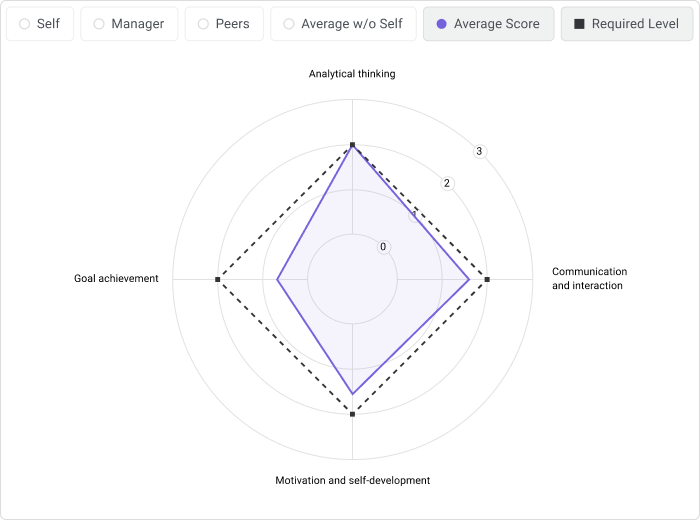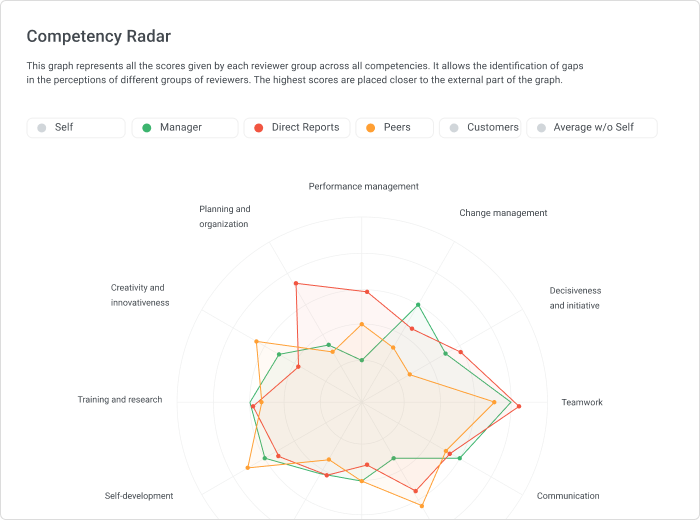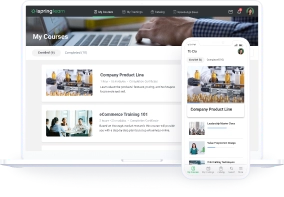Skills Gap Analysis: The Secret to Future-Proofing Your Business

In this article, we’ll walk you through the important steps and strategies for conducting a successful skills gap analysis. You’ll learn how to assess employees’ actual skills and knowledge, along with practical tips to help build a more effective team. Let’s jump in and discover the strength of a thorough skills gap analysis.
What Is a Skills Gap?
A skills gap is a discrepancy between the skills required for a certain job or industry and the skills that job seekers or employees have.
For example, there often aren’t enough people with the coding skills needed for certain software development jobs in the tech world. In healthcare, there could be a shortage of nurses or doctors with specialized training in critical care or specific specialties. This gap can make it difficult to fill job roles and can hold back the hiring process, productivity, and innovation in certain business areas.
Examples of Skills Gaps
Examples of competency gaps will vary depending on a specific position and industry. In general, we can divide knowledge gaps into 4 groups:
Industry-specific skills
These gaps arise when there is a lack of industry-specific knowledge or certifications required for compliance or best practices within a particular sector. These skills include accounting, data analysis, content creation, digital marketing, etc.
Soft skills
Another example is the soft skills gap that’s emerging among Generation Z. The Internet has replaced many in-person experiences for younger generations. These experiences range from social interactions to education, and their disruption was particularly severe during the COVID-19 pandemic. Some examples of soft skills gaps are communication skills, teamwork, decision-making, and creativity.
Leadership skills
The gap may be due to insufficient leadership training, poor communication skills, and team incoherence. Leadership skills include active listening, conflict resolution, delegation, team building, and establishing and nurturing relationships.
Technical skills
These gaps can occur due to rapid technological advancements, outdated training programs, or the adoption of new software and tools. The skills that might be lacking, leading to these gaps, include the efficient use of AI neural networks, and proficiency with software, programming, and engineering, among others.
Why Do Skills Gaps Exist?
These are some of the reasons skills gaps appear:
- The educational system doesn’t keep up with the ever-changing economic environment and evolving technology.
- Young people tend to remain in entry-level roles longer.
- Experienced workers retire, taking their accumulated knowledge, skills, and know-how with them.
- Supervisors and mentors provide poor training.
Why Conduct a Skills Gap Analysis?
A skills gap analysis is a tool for assessing the gap between current employee skills and those skills that employees say they need to perform their jobs effectively. Here are a few reasons why it’s important to conduct it within an organization:
Identifying areas for improvement
A skills gap analysis helps pinpoint employees’ skill gaps and focus on creating the right training and development programs.
Enhanced employee performance
By understanding the skills that need development, companies can provide targeted training to improve the productivity and performance of their staff.
Gaining a competitive advantage
By addressing competency gaps, organizations can ensure that their employees have the necessary skills and expertise to help the company stay competitive in their industry and adapt to market changes.
Increased employee satisfaction
Staff members who receive training and development opportunities to bridge talent gaps are more likely to feel valued and satisfied in their roles, leading to higher retention rates.
Overall, conducting a competency gap assessment helps organizations to better understand their workforce’s capabilities and needs, which leads to improved performance, corporate competitiveness, and employee satisfaction.
Methods for Evaluating Employee Skills
Here are several ways to conduct skill gap analysis:
- Self-assessments. Employees evaluate their own competency levels.
- Manager assessments. The manager assesses the employee’s skills.
- Peer assessments. Coworkers provide feedback on the employee’s competencies.
- 360-degree assessments. Managers, subordinates, and peers evaluate the employee’s skills.
As such, 360-degree assessments effectively evaluate employee competencies, providing a complete overview of critical skills across all business levels. Our guide will explain how to analyze skill gaps with this model.
How to Conduct a Skills Gap Analysis
Organizations often encounter two common roadblocks when conducting talent gap analysis:
- Employees don’t understand the process.
- Results are difficult to analyze.
You can easily avoid these issues with ample preparation and the right tools. Follow our step-by-step guide to conduct a skills gap analysis successfully.
Step 1. Create an effective skills gap analysis plan
Effective planning is crucial. Start by creating a detailed plan that addresses these questions:
- Which business area needs immediate attention? Are certain roles experiencing high turnover? Are specific KPIs not being met?
- How do you plan to communicate the process to employees?
- Who participates in the training gap analysis? These may be stakeholders, like business managers, HR teams, and leaders.
- What is the project timeline for the assessment?
- How will you gather data? Will you use competency-tracking software or handle it manually?
- At what level are you planning to conduct a learning gap analysis? Will you evaluate individuals, teams, departments, or the entire company?
Step 2. Identify the competencies needed to meet the organization’s goals
Just as you would check the weather forecast before scheduling and starting out on a camping trip, consider doing the same for a skill gap assessment.
To identify which competencies the organization will need to remain competitive, assess the organization’s goals for the next three to five years. This involves market analysis to predict industry trends, disruptions, or pivots. Here are some helpful questions to ask:
- What specific skills are required to achieve the business objectives?
- Is there any new technology in your industry?
- How will that affect specific job roles?
- Which technologies are increasingly prevalent in your organization? Are specific competencies becoming more vital in the industry?
Consider these factors to assess if your employees can adapt to these changes.
Once you’ve identified the desired skills, allocate the required skill levels: low, basic, proficient, or expert, as shown in this example:
Step 3. Evaluate current competency levels
Now it’s time to assess the current skill levels in your business. The most effective way is by performing 360-degree evaluations, either manually or digitally.
Manually performing 360-degree employee appraisals can be labor intensive. You can streamline the process with the skills gap analysis template below.
An example of a personal skills gap analysis template
Using specialized software makes conducting 360-degree employee appraisals easier. Some tools assess training gaps independently, while others are integrated into talent management systems (TMS) or learning management systems (LMS).
An LMS is a learning platform used in corporate training and education to build, deliver, and track online training activities.
Remember the two roadblocks we mentioned earlier? An LMS can address both issues. You can communicate with employees directly through the platform, send reminders, and provide instructions for skills assessments. You can also generate detailed reports at an individual, team, or organizational level to track and organize results with ease.
iSpring LMS is a prime example of an LMS with a learning gap analysis tool. This platform helps identify skills gaps and provides training to address them, making it an all-in-one, versatile, and cost-effective solution.
iSpring LMS
Enhance employee performance through the automation of corporate training.
With iSpring’s 360-Degree Performance Appraisal module, you can create a skills gap analysis questionnaire and send it to the employee’s colleagues, from subordinates to management. The platform will create a competency summary highlighting the employee’s strengths and areas for improvement. You can use these performance reviews to assess skills and job fit.
Perform a competency assessment to compare survey results with desired skills. This highlights the team members who are suitable for promotion and identifies those requiring more training.

The competency radar report organizes results according to employee profile and presents evaluations from peers, subordinates, managers, and customers.

With these reports, you can easily identify an employee’s skill gaps.
Want to find out more about competency assessment? Check out our blog post: Skills Mapping 101
Step 4. Close skills gaps
Once you’ve identified skills gaps, prioritize filling them. Don’t try to address all competency gaps simultaneously ー it’s impossible. Consider future company challenges to choose the most efficient strategy for closing gaps.
There are several ways to fill skills gaps; you can:
- Modify your hiring process to find candidates with the desired skill levels (e.g., add skills assessments, etc.).
- Partner with schools and universities to hire interns.
- Train your current workforce.
- Provide leadership training programs and offer mentorships.
- Enhance team building to increase trust and support, identify hidden talents, and strengthen leadership skills.
- Hone communication and negotiation skills to make team collaboration more efficient.
- Opt for outside experts and consultants.
The approach you choose to close a competency gap depends on your urgency, training budget, human resources, and the time needed to upskill the current workforce.
Training current employees is often the most effective strategy for addressing skills gaps. This approach not only closes skills gaps but also increases retention by keeping employees engaged and motivated.
Explore our guide on how to develop an employee training program to kick things off.
Step 5. Estimate outcomes
Closing your workforce’s skills gaps involves more than just conducting a training gap analysis. It’s crucial to assess the success of your training initiatives in addressing talent gaps. These are the steps to take to evaluate whether you’ve performed a successful skills gap analysis:
- Gather feedback from employees on training effectiveness.
- Collect performance reviews from managers to analyze the impact of training.
- Reassess performance regularly to keep an eye on the skills required to fulfill business goals.
Use LMS reports to compare results with previous 360-degree assessments in order to track progress and identify areas that require additional training.
Skills Gap Analysis Template and Checklist (XLS)
Planning a manual analysis? Download our customizable skills gap analysis template and checklist. This free template will provide you with an extensive review of employee performance.
Example of a template for a team skills gap analysis
FAQ on Skills Gap Analysis
The following are the most commonly asked questions about conducting a skills gap analysis:
What is a skills gap analysis?
A skills gap analysis is a tool that organizations use to identify the differences between the skills needed for job roles and the skills their employees have.
Why is a skills gap analysis useful?
When you assess skills gaps, you get valuable insights into the current skills of employees. This valuable information will help you make more informed decisions on business strategy and enhance team performance. For instance, you can:
- Develop long-term recruitment strategies.
- Work on employee strategy.
- Align training and development programs with business goals.
- Improve the person-job fit by creating roadmaps for employee development.
When should an organization conduct a skills gap analysis?
Ideally, businesses will carry out a talent gap assessment annually. With this in mind, conduct a skills gap analysis if:
- You’re going to change your business strategy, model, or organizational structure.
- You’re implementing new technologies, workflows, or processes.
- Your business isn’t performing as it used to.
- Your company is facing high employee turnover.
- The market is likely to change, and this may affect your business.
What are the best tools for conducting a skills gap analysis?
Even though you can assess talent gaps manually (check out our ready-made customizable template), consider automating the process. Discover these top skills gap analysis tools to automate assessments:
| iSpring LMS | iSpring LMS offers comprehensive 360-degree evaluation capabilities. Simply create a questionnaire and share it with reviewers. The LMS will then analyze the results and automatically generate a report. |
| 360Learning | 360Learning is an AI-based eLearning platform. Candidates can gauge their existing skill levels via a summary that combines self-ratings and manager ratings. Based on this, they receive a suggested approach to enhance their skill set. |
| iMocha | iMocha is a skills evaluation tool that lets you analyze existing competencies and then take an upskilling course. The upskilling portal enables you to track individual employees’ progress and company-wide skill levels. |
| MuchSkills | MuchSkills is a platform that helps you hold skills gap analyses. Its visualization feature makes it easy for you to find talent gaps, create actionable competency strategies, and identify upskilling opportunities. |
Wrapping up
Conducting skills gap analyses on an ongoing basis is crucial for businesses striving to cultivate a skilled workforce. By identifying the hard and soft skills that will be required in the future, you can tailor training programs to address gaps and ensure that your teams are prepared for industry demands.
Try out iSpring LMS’s 360-degree performance appraisal tool to conduct a seamless training gap analysis. Start your free 30-day trial now and future-proof your business.







